Search
- Page Path
- HOME > Search
Review Article
- Effectiveness of virtual reality-supported exercise therapy in improving upper extremity function and activities of daily living among patients after stroke: a systematic review of randomized control trials
- Priyanshi Dixit, Uma Phalswal, Nipin Kalal, Saumya P. Srivastava
- Received June 2, 2023 Accepted February 6, 2024 Published online May 24, 2024
- DOI: https://doi.org/10.24171/j.phrp.2023.0148 [Epub ahead of print]
- 424 View
- 11 Download
-
 Abstract
Abstract
 PDF
PDF - This systematic review describes the effectiveness of virtual reality (VR)-supported exercise therapy on upper limb motor function and activities of daily living after stroke. Studies published through January 24, 2022, were identified using CINAHL, Cochrane Library, Embase, Medline, and Web of Science. Randomized control trials comparing VR treatment with conventional therapy (CT) for upper extremity rehabilitation after stroke were included. Methodological quality was assessed using the Cochrane risk-of-bias tool. Of 9 included studies, 5 concluded that the VR group outperformed control participants, 1 indicated the superiority of VR-supported exercises alone over CT, and 3 found VR comparable to CT in promoting upper limb motor function. Five studies analyzed independence in daily living, with 4 reporting no significant difference between VR and CT groups. No strong evidence indicated long-term benefits of VR-assisted exercise. All included studies demonstrated low risk of bias concerning random sequence generation, allocation concealment, outcome assessment blinding, incomplete outcome data, and selective reporting bias. However, a high risk of bias was observed regarding participant blinding due to the nature of the intervention. Most studies suggested that VR, used alongside CT, can improve motor function following stroke. However, the evidence was insufficient to conclude that VR outperforms conventional approaches.
Original Articles
- The association between living arrangements and health-related quality of life in Korean older people: a nationwide repeated cross-sectional study
- Eunok Park, Philip Larkin, Zee-A Han
- Received October 3, 2023 Accepted February 16, 2024 Published online May 23, 2024
- DOI: https://doi.org/10.24171/j.phrp.2023.0273 [Epub ahead of print]
- 207 View
- 9 Download
-
 Abstract
Abstract
 PDF
PDF - Objectives
This study investigated the association between living arrangements and health-related quality of life (HRQoL) in older adults.
Methods
A secondary analysis was conducted of 6,153 participants (aged ≥60 years) from the seventh Korean National Health and Nutrition Examination Survey (2016 to 2018). HRQoL was measured using the 3-level version of the EuroQol 5-dimensional questionnaire. The chi-square test, t-test, and multiple regression were used, applying sampling weights for the analysis.
Results
The proportion of respondents living alone was 18.0%, with a higher prevalence among women and older age groups (p<0.001). The overall HRQoL was lower in groups living alone than in groups living with others (p<0.001). Older people living alone showed higher impairments in all dimensions of the 3-level version of the European Quality of Life 5-Dimensional Questionnaire (EQ-5D-3L) than those living with others, including mobility (p<0.001), self-care (p<0.001), usual activities (p<0.001), pain/discomfort (p<0.001), and depression/anxiety (p<0.001). Problems with mobility were most prevalent (42.8%), followed by pain/discomfort (41.9%) in respondents living alone. Living alone was significantly associated with a lower HRQoL index score (b=–0.048, p<0.001) after adjusting for age, gender, education, exercise, perceived stress, and perceived health status.
Conclusion
Living alone was negatively associated with HRQoL. Based on this study, future care planning for older people should consider their living arrangements. The need to strengthen and expand care programs targeting those living alone should also be addressed.
- Effects of aquatic versus land-based exercise on irisin and fibroblast growth factor 21 expression and triiodothyronine and free fatty acid levels in elderly women
- Du-Wang Kang, Su-Han Koh, Min-Kyo Kim, Do-Yeon Kim
- Received January 3, 2024 Accepted March 6, 2024 Published online May 17, 2024
- DOI: https://doi.org/10.24171/j.phrp.2023.0394 [Epub ahead of print]
- 292 View
- 13 Download
-
 Abstract
Abstract
 PDF
PDF - Objectives
This study investigated the impacts of exercise on irisin and fibroblast growth factor 21 (FGF-21) expression, as well as triiodothyronine (T3) and free fatty acid (FFA) levels in elderly women.
Methods
Thirty women aged 65 to 70 years (10 per group) were randomly assigned to aquatic exercise, land exercise, or control groups. The aquatic and land groups engaged in 3 exercise sessions per week (60 min/session) for 16 weeks. The intensity was progressively increased every 4 weeks.
Results
Irisin and FGF-21 levels significantly increased in the aquatic exercise group. In the post-test, the aquatic exercise group had the highest irisin levels. Significant findings were observed for irisin and FGF-21 for the main effect between aquatic and band exercise groups (p<0.05 for both), the main effect between measurement times (p<0.01 and p<0.001, respectively), and the interaction effect (p<0.05 and p<0.001, respectively). The irisin level was significantly higher in the aquatic than in the land group 30 minutes after the last session (p<0.05). In both exercise groups, T3 levels were significantly higher 30 minutes after the final session (p<0.05) than before the program. The FFA level was significantly higher in the aquatic exercise group than the others. In the aquatic group, FFA levels were significantly higher 30 minutes after both the first (p<0.01) and the last (p<0.001) session compared to pre-program values.
Conclusion
Differences in exercise type and environment can promote fat metabolism by stimulating hormonal changes that induce brown fat activity and browning.
- Prevalence and patterns of post-COVID-19 symptoms in certain recovered patients of Delhi, India: a population-based study
- Nidhi Bhatnagar, Mongjam Meghachandra Singh, Hitakshi Sharma, Suruchi Mishra, Gurmeet Singh, Shivani Rao, Amod Borle, Tanu Anand, Naresh Kumar, Binita Goswami, Sarika Singh, Mahima Kapoor, Sumeet Singla, Bembem Khuraijam, Nita Khurana, Urvi Sharma, Suneela Garg
- Received September 14, 2023 Accepted March 6, 2024 Published online May 17, 2024
- DOI: https://doi.org/10.24171/j.phrp.2023.0251 [Epub ahead of print]
- 197 View
- 9 Download
-
 Abstract
Abstract
 PDF
PDF - Objectives
Post-coronavirus disease 2019 (COVID-19) symptoms were widely reported.However, data on post-COVID-19 conditions following infection with the Omicron variant remained scarce. This prospective study was conducted to understand the prevalence, patterns, and duration of symptoms in patients who had recovered from COVID-19.
Methods
A prospective study was conducted across 11 districts of Delhi, India, among individuals who had recovered from COVID-19. Study participants were enrolled, and then returned for post-recovery follow-up at 3 months and 6 months interval.
Results
The mean age of study participants was 42.07 years, with a standard deviation of 14.89 years. The majority of the participants (79.7%) reported experiencing post-COVID-19 symptoms. The most common symptoms included joint pain (36%), persistent dry cough (35.7%), anxiety (28.4%), and shortness of breath (27.1%). Other symptoms were persistent fatigue (21.6%), persistent headache (20%), forgetfulness (19.7%), and limb weakness (18.6%). The longest duration of symptom was observed to be anxiety (138.75±54.14 days), followed by fatigue (137.57±48.33 days), shortness of breath (131.89±60.21 days), and joint pain/swelling (131.59±58.76 days). At the first follow-up visit, 2.2% of participants presented with abnormal electrocardiogram readings, but no abnormalities were noticed during the second follow-up. Additionally, 4.06% of participants exhibited abnormal chest X-ray findings at the first follow-up, which decreased to 2.16% by the second visit.
Conclusion
The most frequently reported post-COVID-19 symptoms were joint pain, dry cough, anxiety and shortness of breath. These clinical symptoms persisted for up to 6 months, with evidence of multi-system involvement. Consequently, findings highlighted the need for long-term follow-up during the post-COVID-19 period.
- A Mycobacterium bovis outbreak among exhibition animals at a zoo in the Republic of Korea: the first contact investigation of zoonotic tuberculosis
- Hye Young Lee, Yunhyung Kwon, Sang-Eun Lee, Jieun Kim, Hoyong Choi
- Received August 15, 2023 Accepted February 12, 2024 Published online May 17, 2024
- DOI: https://doi.org/10.24171/j.phrp.2023.0228 [Epub ahead of print]
- 453 View
- 11 Download
-
 Abstract
Abstract
 PDF
PDF - Objectives
Between July 2, 2021, and September 20, 2022, a Mycobacterium bovis outbreak occurred among exhibition animals at a zoo in the Republic of Korea. This study was conducted to assess the likelihood of M. bovis transmission to human contacts through a contact investigation and to implement prophylactic treatment for latent tuberculosis infection (LTBI).
Methods
In this descriptive study, the Korea Disease Control and Prevention Agency conducted a contact investigation, which included interviews, interferon-gamma release assay (IGRA) tests, and chest X-rays. Contacts underwent IGRA testing on 2 occasions: initial testing of 29 contacts (15 in the first cluster of infection and 14 in the second) and follow-up testing of the 15 contacts in the first cluster.
Results
The study included 29 participants, 18 of whom were male (62.1%) and 11 female (37.9%). The mean participant age was 37.3 years (standard deviation, 9.6 years). In the initial IGRA tests, 6 of the 29 participants tested positive, indicating a prevalence of 20.7%. Following prolonged exposure, 1 additional positive case was detected in follow-up testing, raising the prevalence of LTBI to 24.1%. None of the contacts had active tuberculosis. Among the 7 individuals with positive results, 2 (28.6%) underwent treatment for LTBI.
Conclusion
This study faced challenges in confirming the transmission of M. bovis infection from infected animals to humans in the Republic of Korea. Nevertheless, adopting a One Health approach necessitates the implementation of surveillance systems and infection control protocols, particularly for occupational groups at high risk of exposure.
Editorial
- Peacetime preparedness for the vaccine adverse event
- Jong-Koo Lee
- Osong Public Health Res Perspect. 2024;15(2):95-96. Published online April 30, 2024
- DOI: https://doi.org/10.24171/j.phrp.2024.0113
- 681 View
- 117 Download
Data Profile
- Establishment of a registry of clinical data and bioresources for rare nervous system diseases
- Dayoung Kim, Sooyoung Kim, Jin Myoung Seok, Kyong Jin Shin, Eungseok Oh, Mi Young Jeon, Joungkyu Park, Hee Jin Chang, Jinyoung Youn, Jeeyoung Oh, Eunhee Sohn, Jinse Park, Jin Whan Cho, Byoung Joon Kim
- Osong Public Health Res Perspect. 2024;15(2):174-181. Published online April 30, 2024
- DOI: https://doi.org/10.24171/j.phrp.2023.0353
- 962 View
- 43 Download
-
 Graphical Abstract
Graphical Abstract
 Abstract
Abstract
 PDF
PDF 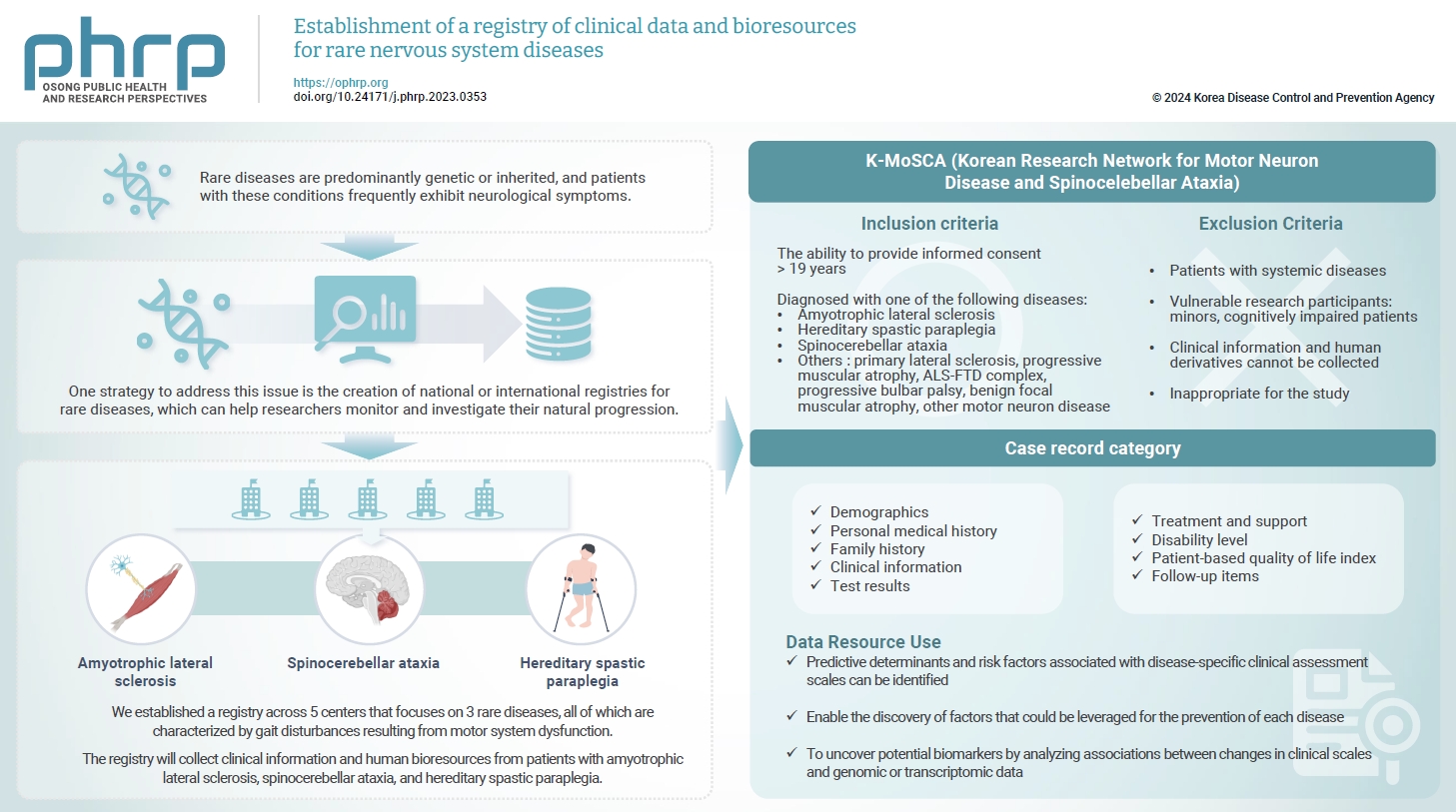
- Rare diseases are predominantly genetic or inherited, and patients with these conditions frequently exhibit neurological symptoms. Diagnosing and treating many rare diseases is a complex challenge, and their low prevalence complicates the performance of research, which in turn hinders the advancement of therapeutic options. One strategy to address this issue is the creation of national or international registries for rare diseases, which can help researchers monitor and investigate their natural progression. In the Republic of Korea, we established a registry across 5 centers that focuses on 3 rare diseases, all of which are characterized by gait disturbances resulting from motor system dysfunction. The registry will collect clinical information and human bioresources from patients with amyotrophic lateral sclerosis, spinocerebellar ataxia, and hereditary spastic paraplegia. These resources will be stored at ICreaT and the National Biobank of Korea. Once the registry is complete, the data will be made publicly available for further research. Through this registry, our research team is dedicated to identifying genetic variants that are specific to Korean patients, uncovering biomarkers that show a strong correlation with clinical symptoms, and leveraging this information for early diagnosis and the development of treatments.
Original Article
- Factors associated with the timely diagnosis of malaria and the utilization of types of healthcare facilities: a retrospective study in the Republic of Korea
- HyunJung Kim, Sangwoo Tak, So-dam Lee, Seongwoo Park, Kyungwon Hwang
- Osong Public Health Res Perspect. 2024;15(2):159-167. Published online April 16, 2024
- DOI: https://doi.org/10.24171/j.phrp.2023.0349
- 909 View
- 44 Download
-
 Graphical Abstract
Graphical Abstract
 Abstract
Abstract
 PDF
PDF 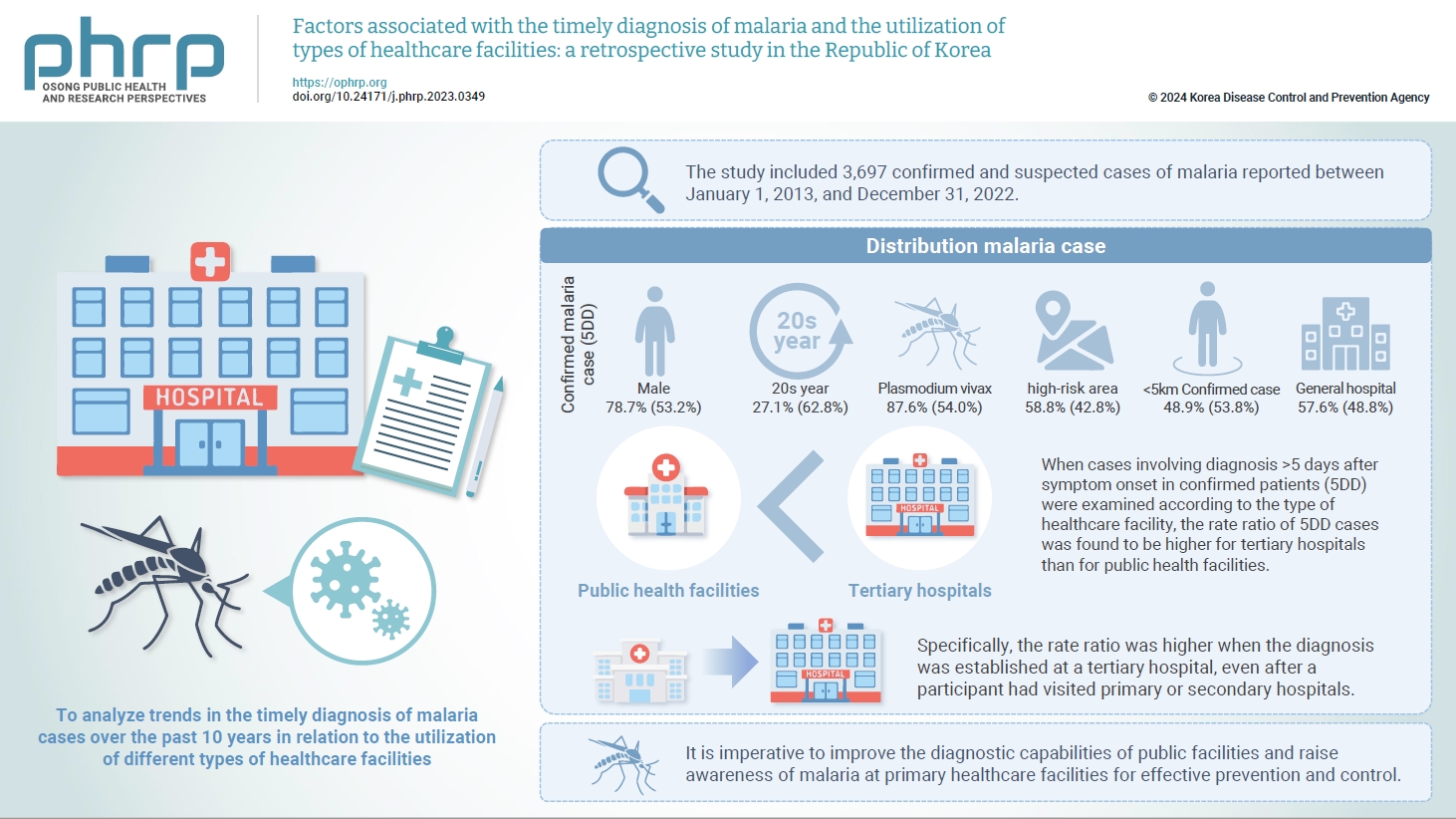
- Objectives
This study aimed to analyze trends in the timely diagnosis of malaria cases over the past 10 years in relation to the utilization of different types of healthcare facilities. Methods: The study included 3,697 confirmed and suspected cases of malaria reported between January 1, 2013, and December 31, 2022, in the national integrative disease and healthcare management system. Some cases lacking a case report or with information missing from the case report were excluded from the analysis. A generalized linear model with a Poisson distribution was constructed to estimate risk ratios and 95% confidence intervals adjusted for other variables, such as distance. Results: When cases involving diagnosis >5 days after symptom onset in confirmed patients (5DD) were examined according to the type of healthcare facility, the risk ratio of 5DD cases was found to be higher for tertiary hospitals than for public health facilities. Specifically, the risk ratio was higher when the diagnosis was established at a tertiary hospital, even after a participant had visited primary or secondary hospitals. In an analysis adjusted for the distance to each participant’s healthcare facility, the results did not differ substantially from the results of the crude analysis. Conclusion: It is imperative to improve the diagnostic capabilities of public facilities and raise awareness of malaria at primary healthcare facilities for effective prevention and control.
Brief Report
- Gender differences in hepatitis A seropositivity rates according to the Republic of Korea’s vaccination policy
- Hyunjin Son, Sunhyun Ahn, Wonseo Park, Gayoung Chun, Unyeong Go, Sang Gon Lee, Eun Hee Lee
- Osong Public Health Res Perspect. 2024;15(2):168-173. Published online April 16, 2024
- DOI: https://doi.org/10.24171/j.phrp.2023.0263
- 1,038 View
- 33 Download
-
 Graphical Abstract
Graphical Abstract
 Abstract
Abstract
 PDF
PDF 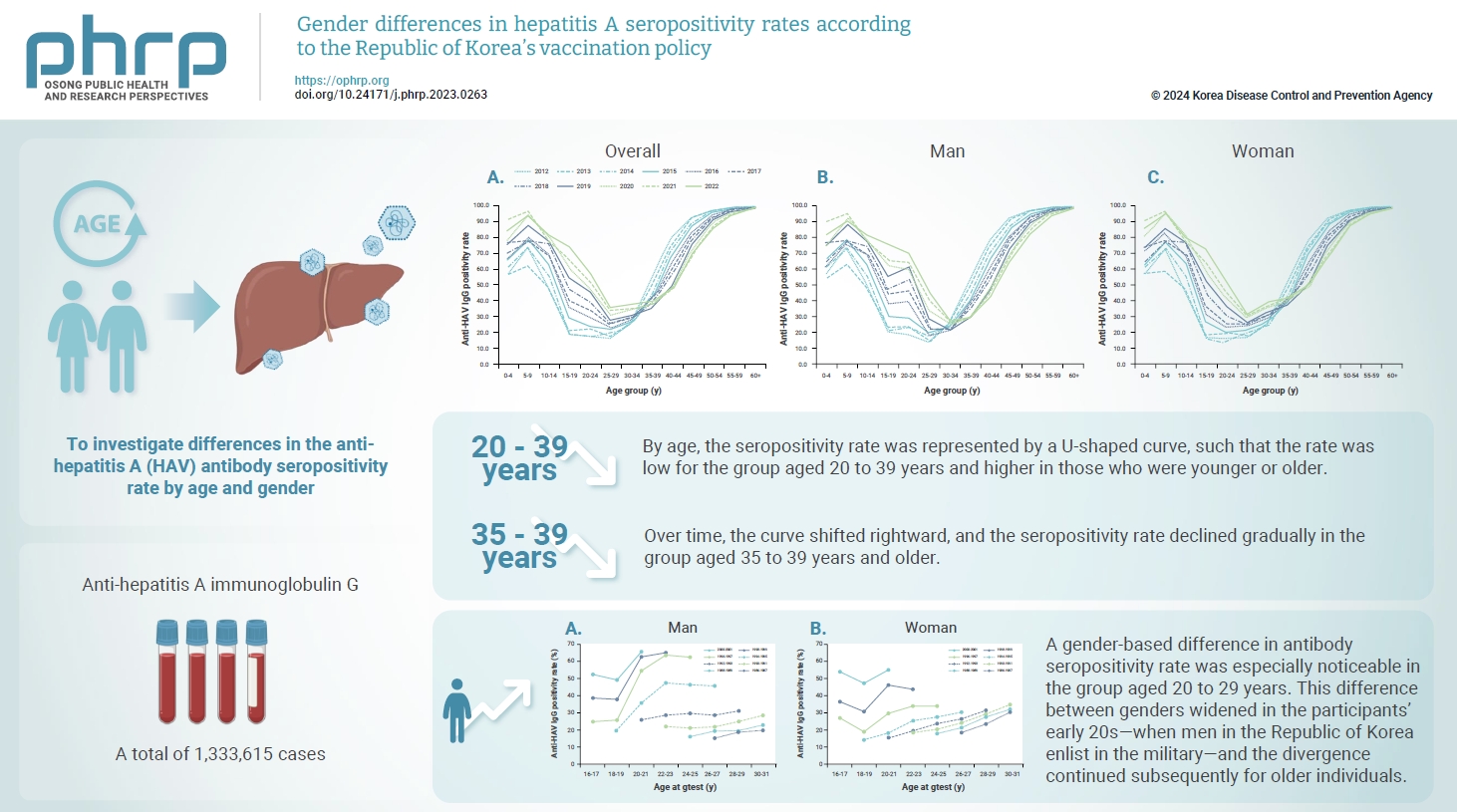
- Objectives
This study aimed to investigate differences in the anti-hepatitis A virus (HAV) antibody seropositivity rate by age and gender. Methods: We collected information on anti-HAV immunoglobulin G and immunoglobulin M status from samples submitted for HAV antibody testing in 2012–2022. A total of 1,333,615 cases were included in the analysis. Results: By age, the seropositivity rate was represented by a U-shaped curve, such that the rate was low for the group aged 20 to 39 years and higher in those who were younger or older. Over time, the curve shifted rightward, and the seropositivity rate declined gradually in the group aged 35 to 39 years and older. A gender-based difference in antibody seropositivity rate was especially noticeable in the group aged 20 to 29 years. This difference between genders widened in the participants’ early 20s—when men in the Republic of Korea enlist in the military—and the divergence continued subsequently for older individuals. Conclusion: These results indicate a higher risk of severe infection among older individuals and a gender-based difference in seroprevalence. Therefore, it is necessary to implement policies to promote vaccination in adults.
Special Article
- The COVID-19 Vaccine Safety Research Center: a cornerstone for strengthening safety evidence for COVID-19 vaccination in the Republic of Korea
- Na-Young Jeong, Hyesook Park, Sanghoon Oh, Seung Eun Jung, Dong-Hyun Kim, Hyoung-Shik Shin, Hee Chul Han, Jong-Koo Lee, Jun Hee Woo, Jaehun Jung, Joongyub Lee, Ju-Young Shin, Sun-Young Jung, Byung-Joo Park, Nam-Kyong Choi
- Osong Public Health Res Perspect. 2024;15(2):97-106. Published online April 4, 2024
- DOI: https://doi.org/10.24171/j.phrp.2023.0343
- 1,544 View
- 73 Download
-
 Graphical Abstract
Graphical Abstract
 Abstract
Abstract
 PDF
PDF 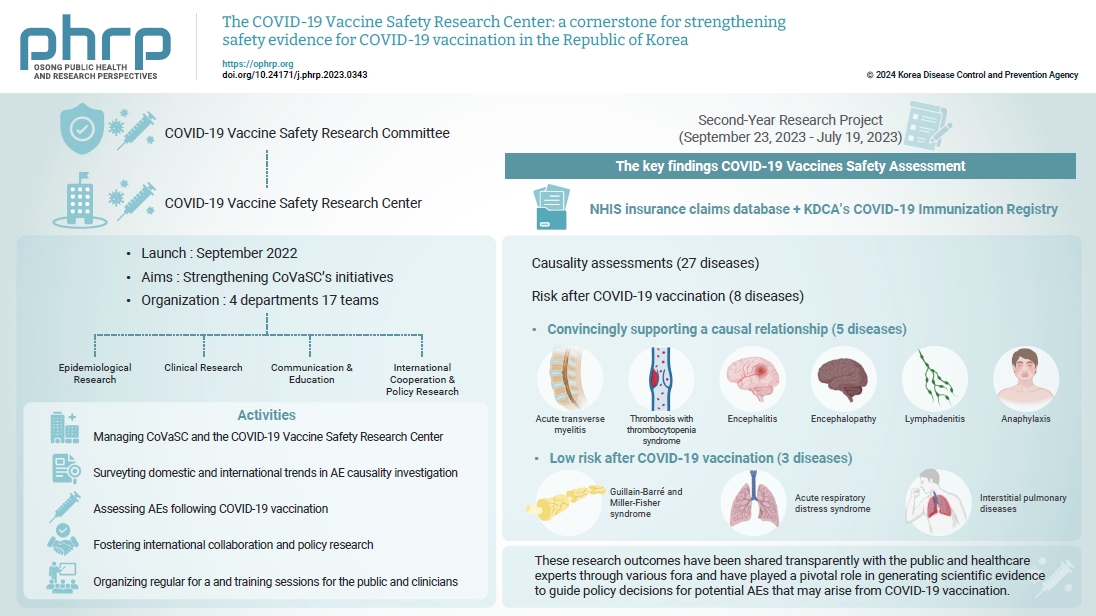
- The COVID-19 Vaccine Safety Research Committee (CoVaSC) was established in November 2021 to address the growing need for independent, in-depth scientific evidence on adverse events (AEs) following coronavirus disease 2019 (COVID-19) vaccination. This initiative was requested by the Korea Disease Control and Prevention Agency and led by the National Academy of Medicine of Korea. In September 2022, the COVID-19 Vaccine Safety Research Center was established, strengthening CoVaSC’s initiatives. The center has conducted various studies on the safety of COVID-19 vaccines. During CoVaSC’s second research year, from September 29, 2022 to July 19, 2023, the center was restructured into 4 departments: Epidemiological Research, Clinical Research, Communication & Education, and International Cooperation & Policy Research. Its main activities include (1) managing CoVaSC and the COVID-19 Vaccine Safety Research Center, (2) surveying domestic and international trends in AE causality investigation, (3) assessing AEs following COVID-19 vaccination, (4) fostering international collaboration and policy research, and (5) organizing regular fora and training sessions for the public and clinicians. Causality assessments have been conducted for 27 diseases, and independent research has been conducted after organizing ad hoc committees comprising both epidemiologists and clinical experts on each AE of interest. The research process included protocol development, data analysis, interpretation of results, and causality assessment. These research outcomes have been shared transparently with the public and healthcare experts through various fora. The COVID-19 Vaccine Safety Research Center plans to continue strengthening and expanding its research activities to provide reliable, high-quality safety information to the public.
Review Article
- Psychiatric adverse events associated with the COVID-19 vaccines approved in the Republic of Korea: a systematic review
- Seungeun Ryoo, Miyoung Choi, Nam-Kyong Choi, Hyoung-Shik Shin, Jun Hee Woo, Byung-Joo Park, Sanghoon Oh
- Osong Public Health Res Perspect. 2024;15(2):107-114. Published online March 28, 2024
- DOI: https://doi.org/10.24171/j.phrp.2023.0325
- 1,467 View
- 68 Download
-
 Graphical Abstract
Graphical Abstract
 Abstract
Abstract
 PDF
PDF 
- This systematic review evaluated psychiatric adverse events (AEs) following vaccination against coronavirus disease 2019 (COVID-19). We included studies that reported or investigated psychiatric AEs in individuals who had received an approved COVID-19 vaccine in the Republic of Korea. Systematic electronic searches of Ovid-Medline, Embase, CENTRAL, and KoreaMed databases were conducted on March 22, 2023. Risk of bias was assessed using the Risk of Bias Assessment Tool for Non-randomized Studies 2.0. The study protocol was registered in the International Prospective Register of Systematic Reviews (CRD42023449422). Of the 301 articles initially selected, 7 were included in the final analysis. All studies reported on sleep disturbances, and 2 highlighted anxiety-related AEs. Sleep disorders like insomnia and narcolepsy were the most prevalent AEs, while depression was not reported. Our review suggests that these AEs may have been influenced by biological mechanisms as well as the broader psychosocial context of the COVID-19 pandemic. Although this study had limitations, such as a primary focus on the BNT162b2 vaccine and an observational study design, it offered a systematic, multi-vaccine analysis that fills a critical gap in the existing literature. This review underscores the need for continued surveillance of psychiatric AEs and guides future research to investigate underlying mechanisms, identify risk factors, and inform clinical management.
Original Articles
- AI-powered COVID-19 forecasting: a comprehensive comparison of advanced deep learning methods
- Muhammad Usman Tariq, Shuhaida Binti Ismail
- Osong Public Health Res Perspect. 2024;15(2):115-136. Published online March 28, 2024
- DOI: https://doi.org/10.24171/j.phrp.2023.0287
- 1,104 View
- 51 Download
-
 Graphical Abstract
Graphical Abstract
 Abstract
Abstract
 PDF
PDF 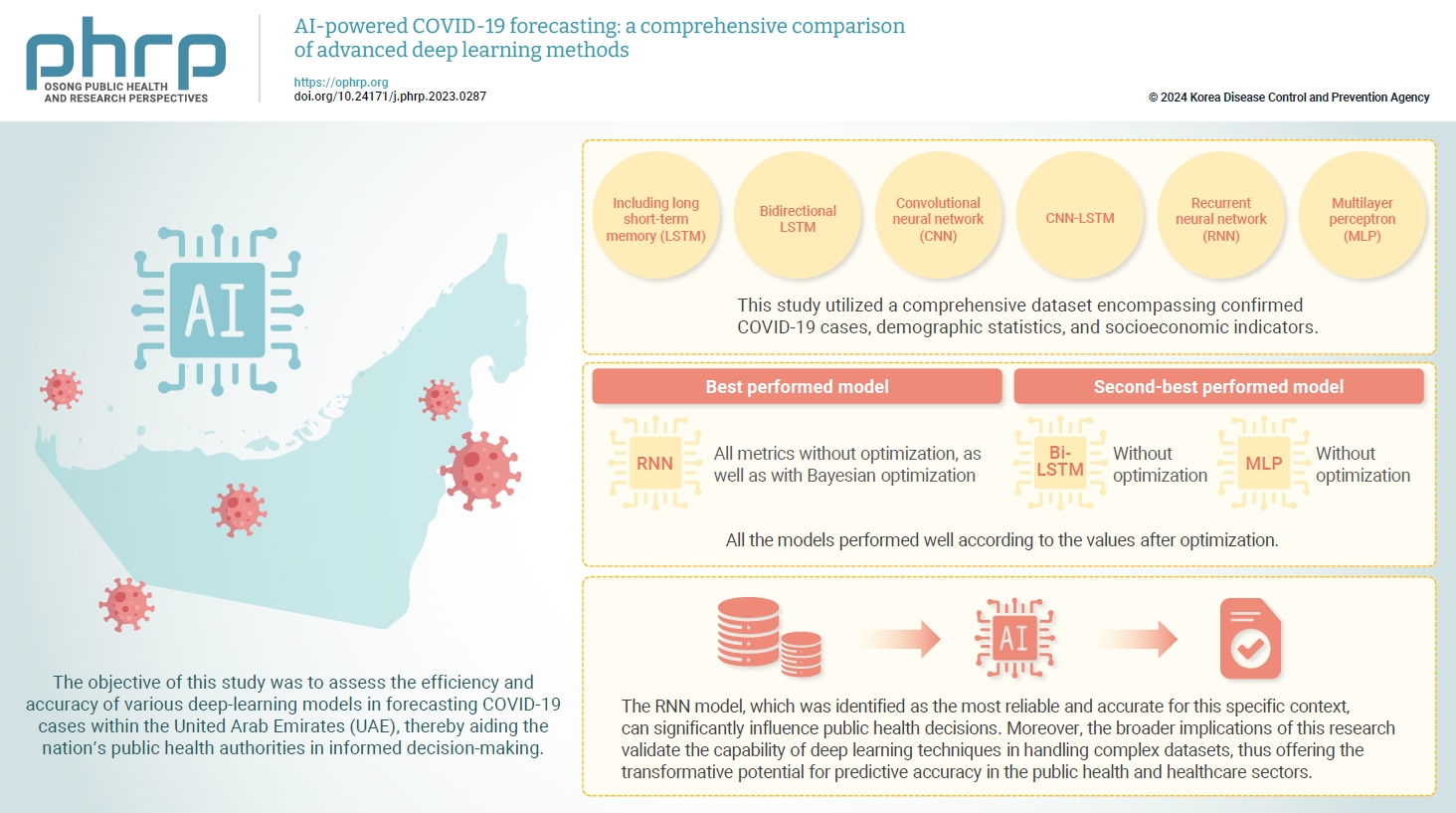
- Objectives
The coronavirus disease 2019 (COVID-19) pandemic continues to pose significant challenges to the public health sector, including that of the United Arab Emirates (UAE). The objective of this study was to assess the efficiency and accuracy of various deep-learning models in forecasting COVID-19 cases within the UAE, thereby aiding the nation’s public health authorities in informed decision-making. Methods: This study utilized a comprehensive dataset encompassing confirmed COVID-19 cases, demographic statistics, and socioeconomic indicators. Several advanced deep learning models, including long short-term memory (LSTM), bidirectional LSTM, convolutional neural network (CNN), CNN-LSTM, multilayer perceptron, and recurrent neural network (RNN) models, were trained and evaluated. Bayesian optimization was also implemented to fine-tune these models. Results: The evaluation framework revealed that each model exhibited different levels of predictive accuracy and precision. Specifically, the RNN model outperformed the other architectures even without optimization. Comprehensive predictive and perspective analytics were conducted to scrutinize the COVID-19 dataset. Conclusion: This study transcends academic boundaries by offering critical insights that enable public health authorities in the UAE to deploy targeted data-driven interventions. The RNN model, which was identified as the most reliable and accurate for this specific context, can significantly influence public health decisions. Moreover, the broader implications of this research validate the capability of deep learning techniques in handling complex datasets, thus offering the transformative potential for predictive accuracy in the public health and healthcare sectors.
- Effect of Paxlovid in COVID-19 treatment during the periods of SARS-CoV-2 Omicron BA.5 and BN.1 subvariant dominance in the Republic of Korea: a retrospective cohort study
- Dong-Hwi Kim, Min-Gyu Yoo, Na-Young Kim, So Young Choi, Minjeong Jang, Misuk An, Se-Jin Jeong, Jungyeon Kim
- Osong Public Health Res Perspect. 2024;15(2):137-149. Published online March 28, 2024
- DOI: https://doi.org/10.24171/j.phrp.2023.0230
- 882 View
- 42 Download
-
 Graphical Abstract
Graphical Abstract
 Abstract
Abstract
 PDF
PDF 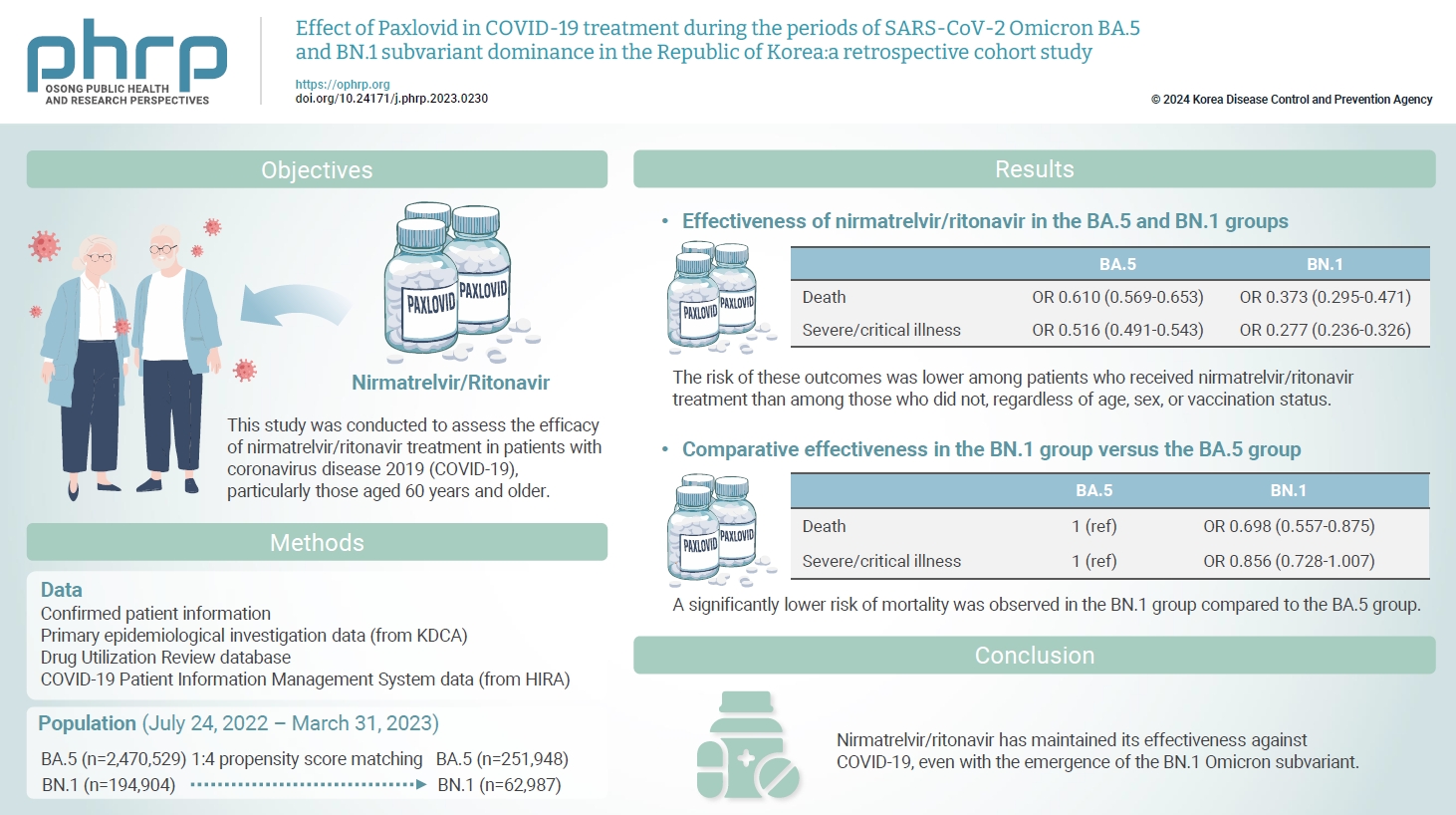
- Objectives
This study was conducted to assess the efficacy of nirmatrelvir/ritonavir treatment in patients with coronavirus disease 2019 (COVID-19), particularly those aged 60 years and older. Using real-world data, the period during which the BN.1 Omicron variant was dominant was compared to the period dominated by the BA.5 variant. Methods: In this retrospective cohort study, data were collected regarding 2,665,281 patients infected with severe acute respiratory syndrome coronavirus 2 between July 24, 2022, and March 31, 2023. Propensity score matching was utilized to match patients who received nirmatrelvir/ ritonavir in a 1:4 ratio between BN.1 and BA.5 variant groups. Multivariable logistic regression analysis was employed to assess the effects of nirmatrelvir/ritonavir within these groups. Results: Compared to the prior period, the efficacy of nirmatrelvir/ritonavir did not significantly differ during the interval of Omicron BN.1 variant dominance in the Republic of Korea. Among patients treated with nirmatrelvir/ritonavir, a significantly lower risk of mortality was observed in the BN.1 group (odds ratio [OR], 0.698; 95% confidence interval [CI], 0.557–0.875) compared to the BA.5 group. However, this treatment did not significantly reduce the risk of severe or critical illness, including death, for those in the BN.1 group (OR, 0.856; 95% CI, 0.728–1.007). Conclusion: Nirmatrelvir/ritonavir has maintained its effectiveness against COVID-19, even with the emergence of the BN.1 Omicron subvariant. Consequently, we strongly recommend the administration of nirmatrelvir/ritonavir to patients exhibiting COVID-19-related symptoms, irrespective of the dominant Omicron variant or their vaccination status, to mitigate disease severity and decrease the risk of mortality.
- COVID-19 infection among people with disabilities in 2021 prior to the Omicron-dominant period in the Republic of Korea: a cross-sectional study
- Seul-Ki Kang, Bryan Inho Kim
- Osong Public Health Res Perspect. 2024;15(2):150-158. Published online March 28, 2024
- DOI: https://doi.org/10.24171/j.phrp.2023.0194
- 936 View
- 28 Download
-
 Graphical Abstract
Graphical Abstract
 Abstract
Abstract
 PDF
PDF 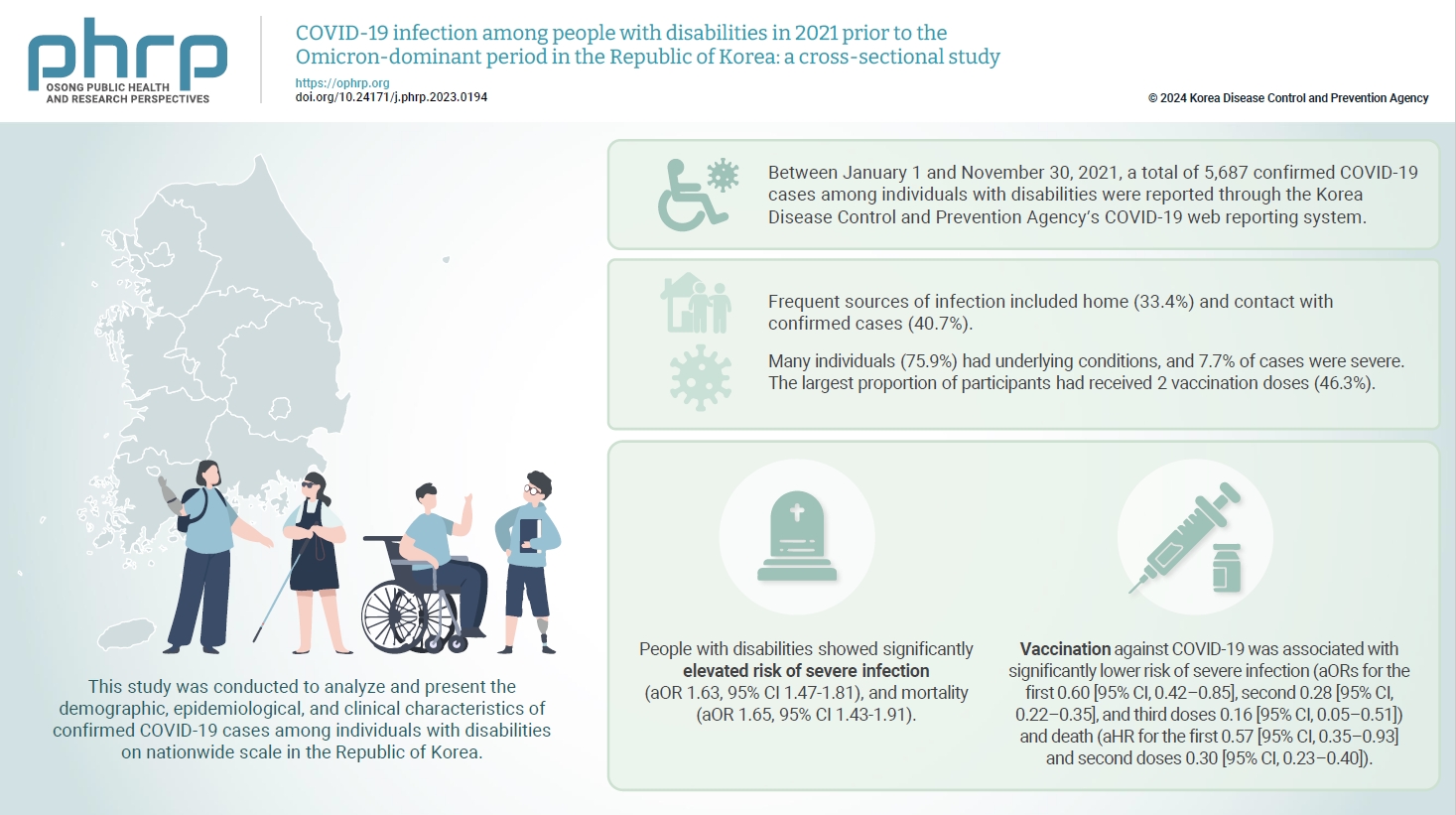
- Objectives
This study investigated the characteristics of coronavirus disease 2019 (COVID-19) among individuals with disabilities on a nationwide scale in the Republic of Korea, as limited research has examined this population. Methods: Between January 1 and November 30, 2021, a total of 5,687 confirmed COVID-19 cases among individuals with disabilities were reported through the Korea Disease Control and Prevention Agency’s COVID-19 web reporting system. Follow-up continued until December 24, and demographic, epidemiological, and clinical characteristics were analyzed. Results: Individuals with disabilities represented approximately 1.5% of confirmed cases, with a mean age of 58.1 years. Most resided in or near metropolitan areas (86.6%) and were male (60.6%). Frequent sources of infection included home (33.4%) and contact with confirmed cases (40.7%). Many individuals (75.9%) had underlying conditions, and 7.7% of cases were severe. People with disabilities showed significantly elevated risk of severe infection (adjusted odds ratio [aOR], 1.63; 95% confidence interval [CI], 1.47–1.81) and mortality (aOR, 1.65; 95% CI, 1.43–1.91). Vaccination against COVID-19 was associated with significantly lower risk of severe infection (aORs for the first, second, and third doses: 0.60 [95% CI, 0.42–0.85], 0.28 [95% CI, 0.22–0.35], and 0.16 [95% CI, 0.05–0.51], respectively) and death (adjusted hazard ratios for the first and second doses: 0.57 [95% CI, 0.35–0.93] and 0.30 [95% CI, 0.23–0.40], respectively). Conclusion: Individuals with disabilities showed higher risk of severe infection and mortality from COVID-19. Consequently, it is critical to strengthen COVID-19 vaccination initiatives and provide socioeconomic assistance for this vulnerable population.
Commentary
- Challenges in capacity building of national immunization programs and emergency or pandemic vaccination responses in the Global Health Security Agenda member countries
- Sookhyun Lee, Jung Ju Oh, Sang Hyun Park, Dasol Ro, Ye Jin Jeong, So Yoon Kim
- Osong Public Health Res Perspect. 2024;15(2):182-185. Published online March 28, 2024
- DOI: https://doi.org/10.24171/j.phrp.2023.0159
- 1,043 View
- 126 Download



 First
First Prev
Prev


